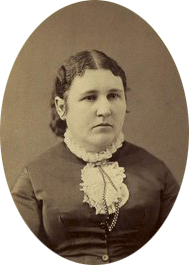History of William Hyde.
Born: 22 September 1832 at Marion, Williamson, Illinois
Parents: William Wood Hyde and Sarah Jackson
Married: Angeline Harris, 13 September 1852 at San Bernardino, California
Married(2): Mary Ann Green, 7 April 1858 at Salt Lake City, Utah
Died: 13 September 1894 at Mancos, Montezuma County, Colorado
WILLIAM HYDE -- A LIFE SKETCH
William Hyde and family were called by Church leaders to settle at Fort Montezuma. He had
crossed the plains with his mother in the wagon train which followed the original Vanguard
Company from Nauvoo to the Salt Lake Valley in 1847. A few years later, William was called
to help settle San Bernardino, California, where he served as a Spanish translator, among
other assignments. He married Angeline Harris while in San Bernardino on September 13,
1852. Soon after their marriage, Brigham Young called them back to Salt Lake City because
of the invasion of Johnston's Army. William secured employment with the city, and
eventually held three important positions at the same time--water master, street
supervisor, and jailer. He supervised prisoners in the laying out of Liberty Park, and
also served as a policeman on occasion. William was known for being exceptionally
motivated. They say he cut a wide swath wherever he went, and often became the reason
for vigorous controversy.
Angeline Harris was born in Burtrand, Missouri. William married a second wife, Mary Ann
Green, on April 7, 1858, at Caldwell County, Missouri. Both wives accompanied William on
the mission to Fort Montezuma, bringing Angeline's children, Parthenia, age 17. Ernest,
14, Frank, 11, and Estella, 5. Mary Ann's children, Helen Athalia, age 21, Mary Luella,
10, and Charles Albert, 5 were also in the caravan. The Hyde family left Salt Lake on
June 27, (1880) with several wagon loads of supplies, with hired teamsters and guards.
The written account of one unidentified hired hand tells of their leaving half of their
supplies at Escalante, and blazing a new trail by way of Halls Crossing. They suffered
many hardships, and traveled long distances without water. He mentions how they sifted
wigglers and polliwogs from the water at first, but said they eventually gave up, and
just drank what water they could find, wigglers and all. The group arived at Fort
Montezuma on September 18th, making the trip from Salt Lake City to Fort Montezuma in
nine days short of three months. When they arrived at the Fort, William was forty-eight,
Angeline was forty-six, and Mary Ann was forty-two. One report claims William's mother
was a cousin to President Andrew Jackson.
They immediately went to work buiilding a substantial cabin, and later built the first
store in San Juan County. It was also called the Indian trading post.
The Hyde family had been asked by Church leaders to establish a wool depot, and to help
the Navajos market their wool. The Hyde family not only built the store, but they rigged
up a cable across the San Juan River with a boat attached, so the Navajo people could
cross the river and do business without having to swim. Thius boat-cable system became a
luxury to the Indians, and a great plaything for the Hyde children. William's son, Ernest,
enjoyed going hand over hand out the cable until he was over the middle. he would drop
into the river and swim back. During November of 1880, Harriet Parthenia Hyde,
affectionately called Feen, or Feenie, by the settlers, was given the assignment of
teaching school at Montezuma.
William Hyde and others built water wheels, and placed them in the San Juan River, to
lift water into the irrigation ditches.>br>
During the spring of 1881, a young Ute man, the son of Sanop, fell in love with Parthenia.
Eventually Sanop approached William Hyde and asked for Parthenia, to be a wife for his son.
William refused, and Sanop threatened to kill him, but William was firm. Sanop backed down,
but it was a severe insult to the Indian. In Indian Culture, he had acted properly and
respectfully, as per Ute Indian custom.
William served as the branch president in Montezuma, and was released in 1883. His home
was the largest and best home in Montezuma, but during the floods of 1884 it was washed
away, and he soon thereafter moved his family to Colorado.
Source: Blue Mountain Shadows, volume 30, Summer 2004
-- Contributed By Edward Christensen


